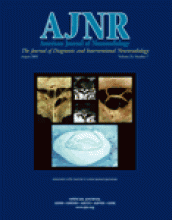Abstract
BACKGROUND AND PURPOSE: We attempted to identify the cause of abnormal venous flow seen during arterial MR angiography in the inferior petrosal sinus by use of in three female patients (aged 51, 48, and 70 years, respectively).
METHODS: Arterial 3D time-of-flight MR angiography was performed with a tilted optimized nonsaturating excitation pulse sequence (TR/TE, 31/7; flip angle, 20 degrees; section thickness, 65 mm; effective thickness, 1 mm; number of sections, 1 to 2); no magnetization transfer pulse sequence was used. Contrast-enhanced 3D MR angiography of the neck was performed with a 3D fast low-angle shot pulse sequence (TR/TE, 4.6/1.8; flip angle, 40 to 45 degrees; section thickness, 80 mm; intersection gap, 1.5 mm; acquisition matrix, 180 × 256; acquisition time, 27 s) on a system with a whole-body coil.
RESULTS: In all three patients, 3D time-of-flight MR angiography revealed abnormal vascular signal originating from the left cavernous sinus, continuing through the inferior petrosal sinus, and ending in the proximal internal jugular vein at the jugular bulb level. Abnormal vascular signal at the jugular bulb, sluggish flow and flow-related enhancement in the left internal jugular vein, and signal void in the contralateral jugular vein were noted. Contrast-enhanced delayed-phase MR angiography showed stenosis in the left brachiocephalic vein in all patients.
CONCLUSION: High signal intensity noted at the inferior petrosal sinus resulted from retrograde flow. Retrograde flow was due to blood stealing from the internal jugular vein toward the cavernous sinus because of venous stenosis in the brachiocephalic vein.
- Copyright © American Society of Neuroradiology












